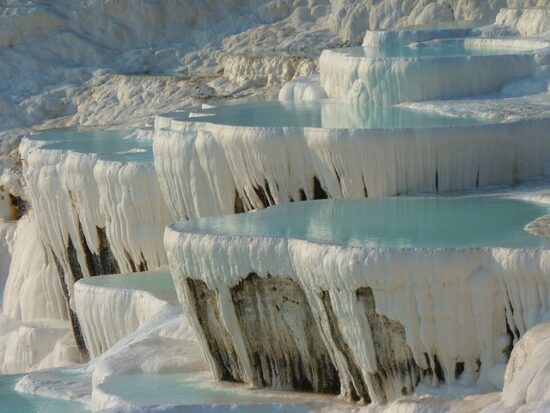Pamukkale, in Turkey means “cotton castle” and this all natural site lives up to the name. This city is found in Denizli Province, in the southwestern region of Turkey. It houses a number of travertines, which are extraordinary phenomena.
Travertines are cascading terraces made of carbonate minerals, which were products of flowing water coming from mountain and volcanic springs. This type of geological formation is so unique in the world that the site was included in the World Heritage Site list of UNESCO. Since its discovery, Pamukkale has become a source of pride for Turkey, and it did not take long for it to be one of the top attractions to see in the country.

Therapeutic Spring Water
There are about 17 hot water springs in the area, and their water heads to the travertine terrace section, leaving calcium carbonate deposits. This gradual process is the reason why the white castle like formations are created. The spring water is believed to be highly therapeutic, especially to the eyes and skin. Some scientific studies also confirmed that Pamukkale water has curing properties for common illnesses like rheumatism and asthma. You can bathe in the site’s artificial pools to capitalize on the therapeutic potentials of the spring water. However, the water in the travertines is off limits, and tourists are prohibited from walking on the terraces to avoid any permanent damage and to preserve their natural form.
Site Exploration
Pamukkale’s white calcium formations are located on the plateau along a steep mountainside. There are three designated entrances to this plateau. You have to pay a corresponding fee to gain access to this archaeological site from any of the entrances.
If you want to stay the night near the site, one of the most convenient options is to look for accommodation in the town of Pamukkale, located just at the foot of the hillside. It also the main access point to travertines and Hierapolis. Though the town is relatively small, it has several hotels and pension houses. If you don’t feel comfortable bathing in public pools, there are a number of hotels in the area that maintain their own thermal mineral water pool. The town is also a good spot to dine and relax, as there are a good number of restaurants, shops and other services.
Hierapolis
This ancient city sits on top of the cascading terraces, and is clearly visible from the neighboring hills and valley. One of the most impressive facts about Hierapolis is its age, which is believed to be about 14000 years old. Aside from the early Roman ruins; you may also find it interesting to visit its grand theater, cemetery and baths. The city maintains a museum called Hieropolis Archaeology Museum, established in 1984, and is a former Roman bath. The museum exhibits a large collection of precious historical artifacts not only found in Hierapolis but in other neighboring towns like Colossae, Attuda, Tripolis and Laodeceaia.
Another great place of interest which shares the fame of the travertines is the Sacred Pool, whose water and mineral content comes from the thermal springs up on the Cal Mountain. It would be almost a sin if you don’t swim around in this pool with the ancient Roman columns and ruins serving as your backdrop.
